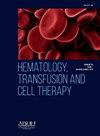急性淋巴细胞白血病患儿体位控制的研究
IF 1.6
Q3 HEMATOLOGY
引用次数: 0
摘要
目的白血病儿童可能面临躯体感觉、运动、肌肉和认知缺陷导致的平衡障碍,这些缺陷可能持续到成年,并增加跌倒的风险。本研究旨在评估接受巩固治疗的急性淋巴细胞白血病(ALL)儿童的姿势控制,通过将他们的表现与规范数据进行比较,以确定潜在的治疗相关的感觉统合和平衡障碍。方法:在土耳其Dokuz eyyl本文章由计算机程序翻译,如有差异,请以英文原文为准。
INVESTIGATION OF POSTURAL CONTROL IN CHILDREN WITH ACUTE LYMPHOBLASTIC LEUKEMIA
Objective
Children with leukemia may face balance impairments due to somatosensory, motor, muscular, and cognitive deficits that can persist into adulthood and increase fall risk. This study aimed to evaluate postural control in children with Acute Lymphoblastic Leukemia (ALL) undergoing consolidation therapy by comparing their performance with normative data to identify potential treatment-related impairments in sensory integration and balance.
Methodology
Thirteen children with ALL were recruited at Dokuz Eylül University, Faculty of Physiotherapy and Rehabilitation in Turkey, and divided into two age groups: 6–7 years (n = 9) and 8–9 years (n = 4). Static balance was evaluated using the modified Clinical Test for Sensory Interaction on Balance (mCTSIB) with the Balance Master system. The test assessed postural control under four conditions: Eyes Open-firm surface (FirmEO), Eyes Closed-firm surface (FirmEC), eyes open-unstable (foam) surface (FoamEO), and eyes closed-unstable (foam) surface (FoamEC). The center of gravity's average sway speed (°/s) was measured for each condition, with higher values indicating reduced balance capability. Normative data for each condition were obtained from previous studies on healthy children.
Results
In the 6–7 years group, sway speeds during FirmEO and FirmEC were 0.92 s and 0.97 s, respectively, compared to norms of 0.70s and 0.92s. Under foam conditions, FoamEO reached 1.31s (norm: 1.20s), while FoamEC was 1.81s, nearly identical to the normative 1.80s. In the 8–9 years group, FirmEO was 0.55s (norm: 0.40s) and FirmEC was 0.65s (norm: 0.53s). FoamEO measured 0.82s (norm: 0.89s), whereas FoamEC was 1.70s (norm: 1.47s). Overall, these results suggest that children with ALL generally exhibit elevated sway speeds ‒ particularly under firm conditions ‒ implying impaired postural control and potential challenges in sensory integration.
Conclusion
Our findings demonstrate that postural control is compromised in children with ALL undergoing consolidation therapy. Elevated sway speeds on firm surfaces suggest diminished balance performance, while the mixed results on foam conditions highlight difficulties with sensory integration. These preliminary observations underscore the need for targeted interventions and further research with larger samples to clarify the mechanisms behind these deficits.
求助全文
通过发布文献求助,成功后即可免费获取论文全文。
去求助
来源期刊

Hematology, Transfusion and Cell Therapy
Multiple-
CiteScore
2.40
自引率
4.80%
发文量
1419
审稿时长
30 weeks
 求助内容:
求助内容: 应助结果提醒方式:
应助结果提醒方式:


